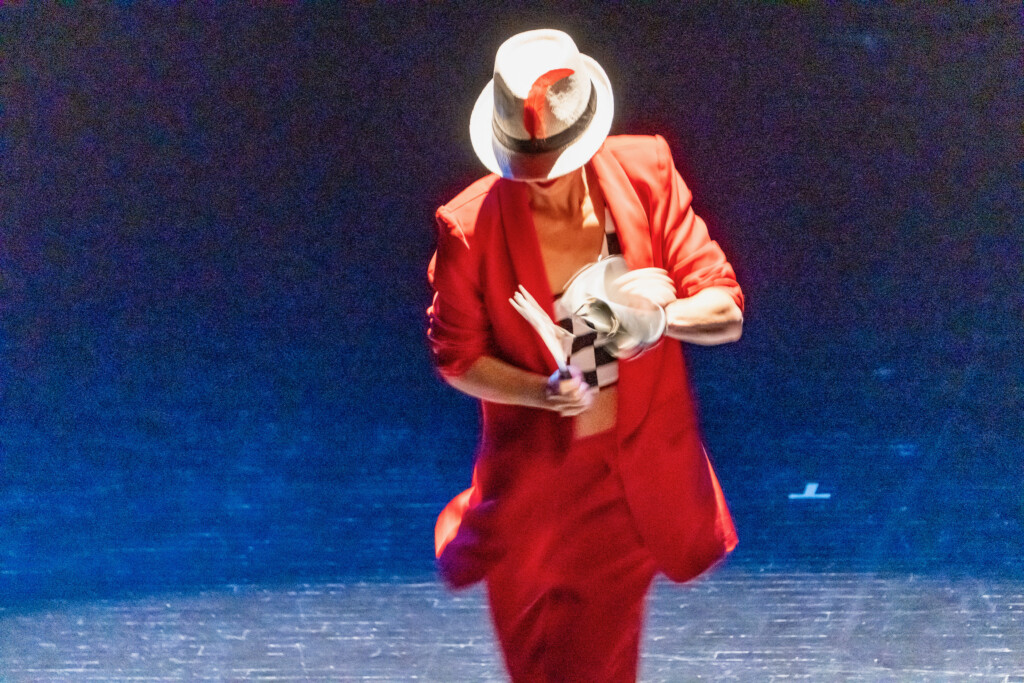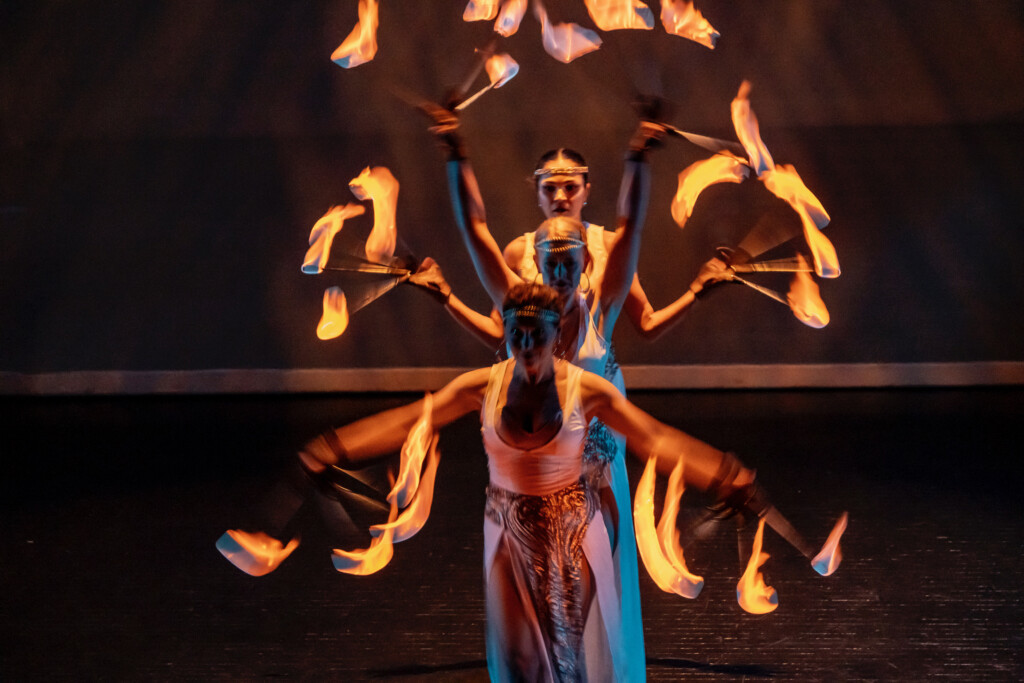Every spring, Samba Fogo’s show is galvanizing in entertainment excellence and respectful cultural education but its most recent Dancestral production is certainly the best of the series to date. It was a tight and exhilarating show that highlighted many roots of Brazil’s uniquely multifarious language of music and dance. This show stood out in representing the Orixá dance movement language as inspired by the rhythms and legends of Afro-Brazilian deities of nature (the Orixá, pronounced as oh-ree-sha) and the cosmology and language of Yoruba, centered in West Africa and found extensively in Nigeria and Benin.
Founded as a volunteer community ensemble of people dedicated to learning about the Afro-Brazilian dance and musical culture at the turn of the millennium, Utah’s award-winning Afro-Brazilian music and dance ensemble flourishes at consistently rising levels of artistic merit. Samba Fogo’s founders, with choreography by Lorin Hansen, the company’s artistic director, and compositions and arrangements by Mason Aeschbacher, the music director, are paragons of sensitive cultural stewardship.
No narration or spoken introductions needed, Dancestral flowed beautifully, segueing from one work to the other, which allowed the specific movement language to express holistically the sentiments that its ancestral roots are unassailable and resilient against any attempts to erase, subvert or compromise their provenance.
The Dancestral counterpoints were skillfully curated. Among the featured performers was Rosangela Silvestre, whose role as teacher and mentor has been central to Samba Fogo’s maturing artistry. With music by George Edgar Brown and choreography by Hansen, Silvestre opened the show in a reverent solo with Iemanjá, Mãe Sereia. The ancestral mother is part of Iyabas, the trio of mothers from the Orixá tradition: Oya (wind), Oxum (freshwater) and Yemanja (all of the planet’s waters). Accompanying the dance was drummer Marivaldo Dos Santos, who provided the Congo De Ouro rhythm. Incidentally, Samba Fogo’s music arm, with orchestra, vocalists and drum ensemble, have paralleled dance in their steady rise to distinguished levels.
Dance roots are strong in their references to womanhood and identity, ranging from Mother Earth to strong feminine Orixá deities to the Malandro and to the reclaiming of the divine feminine spirit. In Guerreiras Do Vento (Female Wind Warriors), inspired by Tempo, the timekeeper tree in the Orixá tradition, Gabriella Nascimento, her dance set to the Ilú rhythmic phrase, swept the audience into kinetic energy. With that, Ignite, the show’s first dance with fire — always a monumental favorite of audiences — elated the audience, with Hansen joined on stage by four other dancers. With its Acacaumbo and Aluja rhythmic phrases, the dance arises from the legends of the equally commanding powers of Oya and her spouse, Xangô, Orixá’s king of fire.
As noted previously in The Utah Review, samba is known as the rhythm of the saints and Brazilian slaves worshiping in their Macumba religion called their many gods by beating drums. Program notes sufficed nicely to explain these foundations: “In Yoruba cosmology, one red feather on the forehead symbolizes our search for Axé (life force energy). The more Axé we have, the more powerful and gentle we become. Yoruba music, dance, language and cultural traditions were forcibly brought to Brazil under the vicissitudes of slavery. Many Brazilian Samba songs reference the Yoruba language and cosmology.”
The string of Samba music and dance numbers comprised a powerhouse emphasizing the group’s strengths. This included A Semente Do Samba (The Seed of Samba), an original song composed by Brown with a memorable horn arrangement, accompanied by Hansen’s choreography. Bravura performances by dancers Mandy Williams and Caleb Mathis put the accent on syncopated samba in Adepto do Samba Sincopado, featuring Jorge Aragão’s song. Caixa Preta’s Caxanga Rosa was delightful, featuring Hansen’s choreography, giving audiences a glimpse into Jongo, a Brazilian tradition of passing good energy from the belly button of a person to another. Oxotocanxoxo highlighted yet another Orixá deity, Oxossi, of the forest, featuring Silvestre, Natalia Andres and Lauren Cheree Wightman — yet another impressive demonstration of the feminine power in these dance traditions.
Cadência Do Samba (Cadence of Samba) is one of the classic warhorses in Samba Fogo’s repertoire. With the song composed by Atualfo Alvez, Hansen, in her own choreography, proves her distinction in interpreting the role of the Malandro, a suave Brazilian character who has the panache of Jeito, which subverts and upends social norms and stifling rules of civility. Hansen’s interpretation was inspired by Madame Satã, the performing name of João Francisco dos Santos (1900–1976), a drag performer and capoeirista in the famed Lapa neighborhood of Rio De Janeiro. In a juried competition at the 2019 International Samba Congress, Hansen’s choreography took the top prize.
Samba Fogo’s meticulous research and networking to bring master teachers in specific areas of dance and music tradition are reflected in their catalog’s original songs and choreography. this included Alma Livre (Free Soul) — an anthem that is acutely timely in the current political turbulence of threats of censorship and authoritarianism. These lyrics notably popped: I’m of a mixed race./I am Brazilian./I’m from the good nature of the “atabaque” drum and the “pandeiro” tambourine./I’ve freed myself from the punishments of the overseer./I’m also free from censorship and dictatorship/ My story is complex, I can’t lie/ But you can’t undervalue what I’ve suffered./My path is that of seeking happiness./Without doubt my destiny is freedom. This sentiment was magnified brilliantly in Hansen’s solo, with her own drum arrangement, in Respeitar Meu Tamborim (Respect My Tamborim).
Likewise, in Reclaim, featuring Your Sweater composed by Hansen and Aeschbacher, the fire dance symbolizes restoring the balance to the planet’s male and female forces. Silvestre returned to the stage in Ancestral Mother, with her own choreography and music composed and improvised by Tyler Chen and Patrick Mac. And, the group featured a number from a course taught last summer by Nascimento, which featured Ze Do Caroço composed by Leci Brandão, a song of major cultural importance for pushing back against erasing Black culture in Brazil. More than 55% of the country’s population identifies as Black or mixed African roots.
Per usual, bringing the audience to its feet in fuller revelry, the production ended with its celebrated Samba Batucada and Samba Fogo’s anthem, which Brown composed, a song that concludes every show. Samba Fogo never rests on its laurels, always building on its extensive research and education As Hansen mentioned in a previous interview with The Utah Review, “It is important that we keep this culture and its tradition alive and vibrant.” Notably, it is shows like Dancestral that have become the group’s best promotional efforts in bringing new students enthused about delving into the authentic dance and music languages that comprise Brazil’s comprehensive cultural diaspora.





